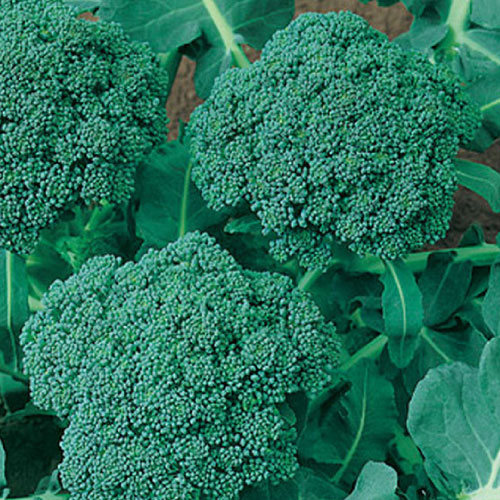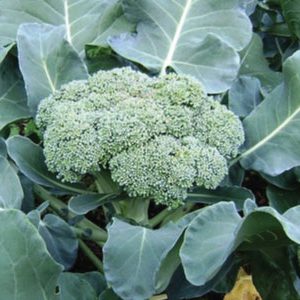
Learning Download: How to Grow Broccoli
From Seed to Harvest: A beginner’s guide to growing broccoli.
Broccoli is a hardy, cool-season vegetables bringing colorful green nutrients to the table. Broccoli is part of the Cole Crop family, which also includes cabbage, kohlrabi, kale and more. It can be grown twice a year, in the late spring and the fall.
To plant:
For a spring crop, plant broccoli seeds indoors six weeks before the last frost and transplant seedlings when they’re four weeks old. For a fall harvest, plant broccoli seeds indoors approximately three months before the first fall frost and transplant the seedlings when they’re four to six weeks old. When planting broccoli, allow for up to 20 inches between plants. Leave 36 inches between the rows.
To grow:
When watering broccoli, do not get water on the developing heads. Some varieties of broccoli are heat tolerant, but still require adequate watering, such as 1 to 1.5 inches of water per week. Broccoli can becomes a target for aphids, cabbage loopers, cabbageworms, mildew and more. Apply soapy to leaves if you see aphids. Mildew can cause yellow spots on leaves if there is moist weather, so try to keep leaves as dry as possible. Handpick cabbageworms and looper off the leaves, but use a floating row cover if the problem gets out of control.
To harvest:
Broccoli is ready to harvest when florets are tightly closed in the center but begin to loosen slightly around the edges. If buds begin to show a yellow color, harvest immediately. Cut the stem at an angle to prevent rot. Sometimes, plants produce another head, so continue to water after harvest. Broccoli typically yields approximately 1 pound per foot of row. Broccoli heads are typically larger during a fall crop than a spring crop.
What broccoli craves:
Broccoli likes nitrogen-rich fertilizer, full sun and moist soil. It does best in a soil with a pH between 6.0 and 7.0, which also discourages clubroot disease. Broccoli likes cool soil, so adding grass clipping around the plants helps. Also, water deeply and often.
Where to buy broccoli seeds:
You can find different variations of broccoli seeds – including green broccoli, purple broccoli, baby broccoli and more at Urban Farmer.
Learning Download: Broccoli Comparison Chart
Broccoli Comparison Chart
| Variety | Days | Maturity | Available in Organic | Disease Resistance |
| Aspabroc Baby | 50 | Early | ||
| De Cicco* | 65-85 | Midseason | ||
| Early Purple Sprouting** | 58-65 | Early | ||
| Fiesta | 65-75 | Midseason | Yes | |
| Green Emperor | 65-75 | Midseason | ||
| Green Sprouting Calabrese** | 65-75 | Midseason | Yes | |
| Happy Rich Baby | 65 | Early | ||
| Premium Crop | 58-65 | Early | Yes | |
| Romanesco** | 75-85 | Late | ||
| Southern Comet | 65-75 | Midseason | ||
| Spring Raab** | 40-45 | Early | ||
| Waltham 29** | 65-75 | Midseason |
*All American Selection Winner
**Heirloom
***AAS Winner/Heirloom
Learning Download: Common pests and diseases: Broccoli
Common pests and diseases: Broccoli
When growing vegetables, it is always exciting to care for the plant throughout its growing phase and then harvest it for delicious recipes later on, but one thing to watch out for is pests and diseases. Different plants are susceptible to different types of pests and diseases, and it is important to make yourself aware so you can keep a watchful eye and also take any preventative methods to keep your plants safe throughout their lifespan.
Broccoli can fall victim to several different pests and diseases.
Pests:
Broccoli is a relatively easy cool-season crop to grow, and it is a popular vegetable to grow as well. However, there are several pests that are attracted to broccoli plants and can inhibit the plant’s growth and even cause death to the plant.
One popular pest is the cabbage worm. Cabbage worms are the larvae of the moths and butterflies. If you see white or gray moths around your broccoli plants, that could be proof that later on, you’ll have problems with the cabbage worms. The cabbage worms feed on the broccoli leaves, which can then cause serious damage. If you see them on the leaves, hand-pick them to remove them. You can also control the younger larvae with certain insecticides that contain Bacillus thuringiensis or spinosad.
Aphids are another pest that can harm broccoli plants. They are tiny insects with soft bodies, and they feed on the broccoli leaves’ undersides. This will cause the leaves to wrinkle or become discolored. Spray the insects with water from the hose and that will knock them off. Use insecticide soap or neem oil to treat infestations.

Another pest affecting broccoli plants is the flea beetle. Flea beetles are small, black insects which cause holes in the foliage of the plant. If flea beetles continue to feed, it can kill seedlings or, if the plants are older, reduce yield. To treat, use insecticides that are specifically for flea beetles. The beetles can overwinter in the soil, so to prevent that issue, make sure you clean up your end of season crop well.
Cutworms are another popular pest affecting broccoli, and they usually feed at night. To prevent this, you can plant seedlings instead of seeds and wrap collars around the stems to protect them.
Diseases:
In addition to pests, diseases can also cause issues to broccoli plants. Certain diseases are mostly bacterial or fungal. Certain leaf spot diseases can affect the plants. The best way to prevent disease is to rotate the crops and don’t plant Cole family plants in the same area for more than once every three years. Also be sure to space out your plants well to provide proper air circulation.

